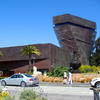When Charles Green Shaw fell under the spell of European abstraction, he became free to explore the limits of his own artmaking.
Shaw loved to discover new artists and incorporate their stylistic lessons into his own works. He admired artists like Joan Miró and Paul Klee, both of whose inspiration can be felt in this work, with its vaguely humanlike figure. Seeing this cute and blushing Humpty-Dumpty character with a plant for a nose, it's not hard to see how Shaw made the leap to children's books. He published It Looked Like Spilt Milk in 1947, a picture book for kids that introduces them to abstract art by allowing them to imagine animals and other objects from drawings of "spilt milk," like daydreaming various pictures while watching clouds in the sky.
As the Great Depression hit the rest of the country, Shaw was discovering his love for painting. By 1932, he had committed himself to creating abstract worlds using a paintbrush. His advanced works look like the precursors to Frank Stella’s geometric abstractions. However, unlike the Abstract Expressionists who came after him, Shaw mainly painted small canvases. This was for the simple fact that Shaw lived in a New York apartment, and he could only create paintings that fit in the building’s elevator. This explains Untitled's somewhat diminutive size.
Like most other artists, Shaw had to ease himself into abstraction. This example of a non-representational artwork could not have happened without his earlier stages of understanding how to break scenes down into the planes, shapes, and forms that he observed. As Piet Mondrian turned to nature and broke down trees into their shapes, light, and shadow, Shaw used what was familiar to him – the Manhattan skyline. He observed and painted until he could envision abstracted versions of the scenes that he experienced since he was young. Though Untitled looks a far cry from the rigid lines and gray steel buildings of Manhattan, Shaw's use of grid forms is reminiscent of city blocks, and the colorful curves and playfulness in this piece evoke how a child might see NYC, or in a dream (or how an adult might experience it on an acid trip).
As a foundational member of the American Abstract Artists group, Shaw’s work is highly sought after and is in a number of landmark collections of abstract art. This particular abstraction made it to San Francisco by way of David Davies and Jack Weeden, life partners and art collectors who were well-known in the local art scene. Although they were together for over forty-five years, restrictions on gay marriage did not allow them to wed legally until late 2011, a mere three months before Davies’ death in 2012. Among a variety of other interests, Weeden and Davies collected American abstract art from the 1930s to the 1950s, with their pieces filling their shared San Francisco home. Their secret to building a quality collection? Buy what you like, not what you think will make money.
















I really like this piece of art work because it is untitled which adds to the weirdness going on. It has many different colors and lines happening which go well with what I think is a plant drawn in the middle.